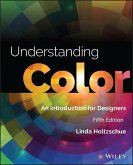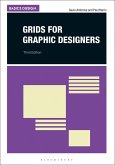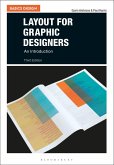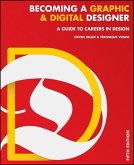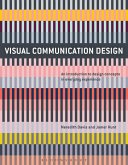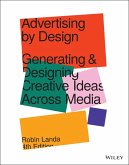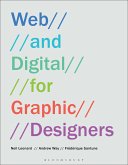Linda Holtzschue
Understanding Color: An Introduction for Designers (eBook, PDF)
65,99 €
65,99 €
inkl. MwSt.
Sofort per Download lieferbar

0 °P sammeln
65,99 €
Als Download kaufen

65,99 €
inkl. MwSt.
Sofort per Download lieferbar

0 °P sammeln
Jetzt verschenken
Alle Infos zum eBook verschenken
65,99 €
inkl. MwSt.
Sofort per Download lieferbar
Alle Infos zum eBook verschenken

0 °P sammeln
Linda Holtzschue
Understanding Color: An Introduction for Designers (eBook, PDF)
- Format: PDF
- Merkliste
- Auf die Merkliste
- Bewerten Bewerten
- Teilen
- Produkt teilen
- Produkterinnerung
- Produkterinnerung

Bitte loggen Sie sich zunächst in Ihr Kundenkonto ein oder registrieren Sie sich bei
bücher.de, um das eBook-Abo tolino select nutzen zu können.
Hier können Sie sich einloggen
Hier können Sie sich einloggen
Sie sind bereits eingeloggt. Klicken Sie auf 2. tolino select Abo, um fortzufahren.

Bitte loggen Sie sich zunächst in Ihr Kundenkonto ein oder registrieren Sie sich bei bücher.de, um das eBook-Abo tolino select nutzen zu können.
Today's business world relies on effective use of color to promote its products, both tangible goods and images. Understanding Color has long stood as an indispensable introduction to the effective use of color for design applications, with detailed treatment of the language, psychology, cultural associations, core concepts of color and much more. Reorganized and updated to reflect the needs of today's courses in color and design, it introduces a new generation of artists and designers to the fundamental concepts of color and how to use them.
Detailed treatment of color illusions and…mehr
- Geräte: PC
- mit Kopierschutz
- eBook Hilfe
- Größe: 19.43MB
Andere Kunden interessierten sich auch für
![Understanding Color (eBook, PDF) Understanding Color (eBook, PDF)]() Linda HoltzschueUnderstanding Color (eBook, PDF)63,99 €
Linda HoltzschueUnderstanding Color (eBook, PDF)63,99 €![Grids for Graphic Designers (eBook, PDF) Grids for Graphic Designers (eBook, PDF)]() Gavin AmbroseGrids for Graphic Designers (eBook, PDF)21,95 €
Gavin AmbroseGrids for Graphic Designers (eBook, PDF)21,95 €![Layout for Graphic Designers (eBook, PDF) Layout for Graphic Designers (eBook, PDF)]() Gavin AmbroseLayout for Graphic Designers (eBook, PDF)22,95 €
Gavin AmbroseLayout for Graphic Designers (eBook, PDF)22,95 €![Becoming a Graphic and Digital Designer (eBook, PDF) Becoming a Graphic and Digital Designer (eBook, PDF)]() Steven HellerBecoming a Graphic and Digital Designer (eBook, PDF)40,99 €
Steven HellerBecoming a Graphic and Digital Designer (eBook, PDF)40,99 €![Visual Communication Design (eBook, PDF) Visual Communication Design (eBook, PDF)]() Meredith DavisVisual Communication Design (eBook, PDF)26,95 €
Meredith DavisVisual Communication Design (eBook, PDF)26,95 €![Advertising by Design (eBook, PDF) Advertising by Design (eBook, PDF)]() Robin LandaAdvertising by Design (eBook, PDF)66,99 €
Robin LandaAdvertising by Design (eBook, PDF)66,99 €![Web and Digital for Graphic Designers (eBook, PDF) Web and Digital for Graphic Designers (eBook, PDF)]() Neil LeonardWeb and Digital for Graphic Designers (eBook, PDF)25,95 €
Neil LeonardWeb and Digital for Graphic Designers (eBook, PDF)25,95 €-
-
-
Today's business world relies on effective use of color to promote its products, both tangible goods and images. Understanding Color has long stood as an indispensable introduction to the effective use of color for design applications, with detailed treatment of the language, psychology, cultural associations, core concepts of color and much more. Reorganized and updated to reflect the needs of today's courses in color and design, it introduces a new generation of artists and designers to the fundamental concepts of color and how to use them.
From theory and practical implementation to business and marketing aspects, Understanding Color is ideal for students and instructors in schools of art and design.
- Detailed treatment of color illusions and special effects
- Coverage of the impact of new light sources on color perception
- Explanation of different digital display modes in presenting color
- A companion website including a downloadable workbook
From theory and practical implementation to business and marketing aspects, Understanding Color is ideal for students and instructors in schools of art and design.
Dieser Download kann aus rechtlichen Gründen nur mit Rechnungsadresse in D ausgeliefert werden.
Produktdetails
- Produktdetails
- Verlag: John Wiley & Sons
- Seitenzahl: 209
- Erscheinungstermin: 19. März 2025
- Englisch
- ISBN-13: 9781394186747
- Artikelnr.: 73694434
- Verlag: John Wiley & Sons
- Seitenzahl: 209
- Erscheinungstermin: 19. März 2025
- Englisch
- ISBN-13: 9781394186747
- Artikelnr.: 73694434
- Herstellerkennzeichnung Die Herstellerinformationen sind derzeit nicht verfügbar.
Linda Holtzschue is Principal of Linda Holtzschue and Associates, a New York City-based interior design firm. She taught color theory and other courses at the Fashion Institute of Technology and the Parsons School of Design, where she also served as an assistant dean. Her work has been featured in the New York Times Magazine and has appeared in Better Homes and Gardens.
Preface ix
Acknowledgments xi
About the Companion Website xiii
Chapter 1 The Role of Color in Design
The Role of Color in Design 1
Color as Language 2
Culture, Color, and Time 3
Color, Form, and Arrangement: Communication without Words 4
Clothing and Color: Social Messaging 6
Color Coding 8
Chapter 2 An Introduction to Color Study
The Experience of Color 11
Color Awareness 11
The Uses of Color 14
Color-Order Systems 16
Color Study 20
Chapter 3 A Little Light on The Subject
Light 23
Light Sources 24
Modifying Light 26
Additive Color: Mixing Light 30
Subtractive Color 31
Colorants 31
Man-made Light Sources: Past, Present, and the Future at a Crossroad 34
Color Temperature 36
Metamerism and Matching 38
Modifying Light: Surface 38
Transparent, Opaque, and Translucent 40
Iridescence 41
Luminosity 42
Indirect Light, Indirect Color 42
Modifying Light: Filters 43
Chapter 4 The Vocabulary of Color
Hue 46
The Artists' Spectrum 47
Primary, Secondary, and Intermediate Colors 48
Saturated Color 49
Other Spectrums, Other Primaries 49
Chromatic Scales 50
Cool and Warm Colors 50
Analogous Colors 51
Complementary Colors 52
Tertiary Colors: Chromatic Neutrals 53
Black, White, Gray 54
Value 55
Tints and Shades 59
Monochromatic Value Scales 60
Comparing Value in Different Hues 60
Saturation 62
Theoretical Gray 65
Tone 65
Chapter 5 The Human Element
The Sensation of Color 67
Vision: Responding to Light 67
Threshold 69
Intervals 69
The Perception of Color 72
Physiological Responses to Light 73
Healing and Color 74
Synaesthesia 75
Psychology: Responding to Light 75
Chapter 6 The Instability of Colors
The Instability of Colors 77
Color Composition 78
Ground and Carried Colors 78
Placement and Color Change 79
Equilibrium 80
Simultaneous Contrast 81
Afterimage and Contrast Reversal 82
Complementary Contrast 83
Ground Subtraction 85
Color and Area: Small, Medium, Large 86
Chapter 7 Illusion and Impression
Color Illusions 90
The Illusion of Depth 90
Spatial Effects of Colors 92
Transparence Illusion 94
Fluting 96
Vibration 97
Vanishing Boundaries 98
Luminosity 98
Bezold Effect 99
Optical Mixes 100
Chapter 8 Color Theory: A Brief History
The Mystery of Color 103
Setting the Stage 103
The Beginnings of Color Theory 104
Color and Controversy 107
The Scientific Model: Color Gets Organized 108
Color by Numbers 111
A New Perspective 113
Chapter 9 Color Harmony
In Search of Beauty 115
Intervals and Harmony 116
Hue and Harmony 117
Major and Minor Themes 118
Value and Harmony 118
Saturation and Harmony 120
On Beyond Harmony: Dissonant Colors 121
The X-Tra Factor: Surface and Harmony 121
Some Harmonious Conclusions 122
Chapter 10 Tools of the Trade: Color in Product and Print
It's the Real Thing: Color on Product and Print 124
Design Media 125
Artists' Media 126
Subtractive Mixing 127
Muted Hues 128
Tinting Strength 129
Color Printing 129
Spot Colors 131
Screen and Block Printing 132
Chapter 11 The Medium of Light
Images of Light 133
Lost in Translation 135
The Screen Display 137
Color Display Modes 139
Color Management 140
Color on the Web 143
Web Color Coding 144
Emerging Media: E-Ink 147
Chapter 12 The Business of Color
The Color Industries 149
Color Sampling 151
Color Forecasting 151
Color Consulting 153
Color and Product Identity 156
Palettes, Color Cycles, and History 158
Traditional and Document Colors 160
Influences on Palettes 162
Glossary 165
Bibliography 177
Index 181
Acknowledgments xi
About the Companion Website xiii
Chapter 1 The Role of Color in Design
The Role of Color in Design 1
Color as Language 2
Culture, Color, and Time 3
Color, Form, and Arrangement: Communication without Words 4
Clothing and Color: Social Messaging 6
Color Coding 8
Chapter 2 An Introduction to Color Study
The Experience of Color 11
Color Awareness 11
The Uses of Color 14
Color-Order Systems 16
Color Study 20
Chapter 3 A Little Light on The Subject
Light 23
Light Sources 24
Modifying Light 26
Additive Color: Mixing Light 30
Subtractive Color 31
Colorants 31
Man-made Light Sources: Past, Present, and the Future at a Crossroad 34
Color Temperature 36
Metamerism and Matching 38
Modifying Light: Surface 38
Transparent, Opaque, and Translucent 40
Iridescence 41
Luminosity 42
Indirect Light, Indirect Color 42
Modifying Light: Filters 43
Chapter 4 The Vocabulary of Color
Hue 46
The Artists' Spectrum 47
Primary, Secondary, and Intermediate Colors 48
Saturated Color 49
Other Spectrums, Other Primaries 49
Chromatic Scales 50
Cool and Warm Colors 50
Analogous Colors 51
Complementary Colors 52
Tertiary Colors: Chromatic Neutrals 53
Black, White, Gray 54
Value 55
Tints and Shades 59
Monochromatic Value Scales 60
Comparing Value in Different Hues 60
Saturation 62
Theoretical Gray 65
Tone 65
Chapter 5 The Human Element
The Sensation of Color 67
Vision: Responding to Light 67
Threshold 69
Intervals 69
The Perception of Color 72
Physiological Responses to Light 73
Healing and Color 74
Synaesthesia 75
Psychology: Responding to Light 75
Chapter 6 The Instability of Colors
The Instability of Colors 77
Color Composition 78
Ground and Carried Colors 78
Placement and Color Change 79
Equilibrium 80
Simultaneous Contrast 81
Afterimage and Contrast Reversal 82
Complementary Contrast 83
Ground Subtraction 85
Color and Area: Small, Medium, Large 86
Chapter 7 Illusion and Impression
Color Illusions 90
The Illusion of Depth 90
Spatial Effects of Colors 92
Transparence Illusion 94
Fluting 96
Vibration 97
Vanishing Boundaries 98
Luminosity 98
Bezold Effect 99
Optical Mixes 100
Chapter 8 Color Theory: A Brief History
The Mystery of Color 103
Setting the Stage 103
The Beginnings of Color Theory 104
Color and Controversy 107
The Scientific Model: Color Gets Organized 108
Color by Numbers 111
A New Perspective 113
Chapter 9 Color Harmony
In Search of Beauty 115
Intervals and Harmony 116
Hue and Harmony 117
Major and Minor Themes 118
Value and Harmony 118
Saturation and Harmony 120
On Beyond Harmony: Dissonant Colors 121
The X-Tra Factor: Surface and Harmony 121
Some Harmonious Conclusions 122
Chapter 10 Tools of the Trade: Color in Product and Print
It's the Real Thing: Color on Product and Print 124
Design Media 125
Artists' Media 126
Subtractive Mixing 127
Muted Hues 128
Tinting Strength 129
Color Printing 129
Spot Colors 131
Screen and Block Printing 132
Chapter 11 The Medium of Light
Images of Light 133
Lost in Translation 135
The Screen Display 137
Color Display Modes 139
Color Management 140
Color on the Web 143
Web Color Coding 144
Emerging Media: E-Ink 147
Chapter 12 The Business of Color
The Color Industries 149
Color Sampling 151
Color Forecasting 151
Color Consulting 153
Color and Product Identity 156
Palettes, Color Cycles, and History 158
Traditional and Document Colors 160
Influences on Palettes 162
Glossary 165
Bibliography 177
Index 181
Preface ix
Acknowledgments xi
About the Companion Website xiii
Chapter 1 The Role of Color in Design
The Role of Color in Design 1
Color as Language 2
Culture, Color, and Time 3
Color, Form, and Arrangement: Communication without Words 4
Clothing and Color: Social Messaging 6
Color Coding 8
Chapter 2 An Introduction to Color Study
The Experience of Color 11
Color Awareness 11
The Uses of Color 14
Color-Order Systems 16
Color Study 20
Chapter 3 A Little Light on The Subject
Light 23
Light Sources 24
Modifying Light 26
Additive Color: Mixing Light 30
Subtractive Color 31
Colorants 31
Man-made Light Sources: Past, Present, and the Future at a Crossroad 34
Color Temperature 36
Metamerism and Matching 38
Modifying Light: Surface 38
Transparent, Opaque, and Translucent 40
Iridescence 41
Luminosity 42
Indirect Light, Indirect Color 42
Modifying Light: Filters 43
Chapter 4 The Vocabulary of Color
Hue 46
The Artists' Spectrum 47
Primary, Secondary, and Intermediate Colors 48
Saturated Color 49
Other Spectrums, Other Primaries 49
Chromatic Scales 50
Cool and Warm Colors 50
Analogous Colors 51
Complementary Colors 52
Tertiary Colors: Chromatic Neutrals 53
Black, White, Gray 54
Value 55
Tints and Shades 59
Monochromatic Value Scales 60
Comparing Value in Different Hues 60
Saturation 62
Theoretical Gray 65
Tone 65
Chapter 5 The Human Element
The Sensation of Color 67
Vision: Responding to Light 67
Threshold 69
Intervals 69
The Perception of Color 72
Physiological Responses to Light 73
Healing and Color 74
Synaesthesia 75
Psychology: Responding to Light 75
Chapter 6 The Instability of Colors
The Instability of Colors 77
Color Composition 78
Ground and Carried Colors 78
Placement and Color Change 79
Equilibrium 80
Simultaneous Contrast 81
Afterimage and Contrast Reversal 82
Complementary Contrast 83
Ground Subtraction 85
Color and Area: Small, Medium, Large 86
Chapter 7 Illusion and Impression
Color Illusions 90
The Illusion of Depth 90
Spatial Effects of Colors 92
Transparence Illusion 94
Fluting 96
Vibration 97
Vanishing Boundaries 98
Luminosity 98
Bezold Effect 99
Optical Mixes 100
Chapter 8 Color Theory: A Brief History
The Mystery of Color 103
Setting the Stage 103
The Beginnings of Color Theory 104
Color and Controversy 107
The Scientific Model: Color Gets Organized 108
Color by Numbers 111
A New Perspective 113
Chapter 9 Color Harmony
In Search of Beauty 115
Intervals and Harmony 116
Hue and Harmony 117
Major and Minor Themes 118
Value and Harmony 118
Saturation and Harmony 120
On Beyond Harmony: Dissonant Colors 121
The X-Tra Factor: Surface and Harmony 121
Some Harmonious Conclusions 122
Chapter 10 Tools of the Trade: Color in Product and Print
It's the Real Thing: Color on Product and Print 124
Design Media 125
Artists' Media 126
Subtractive Mixing 127
Muted Hues 128
Tinting Strength 129
Color Printing 129
Spot Colors 131
Screen and Block Printing 132
Chapter 11 The Medium of Light
Images of Light 133
Lost in Translation 135
The Screen Display 137
Color Display Modes 139
Color Management 140
Color on the Web 143
Web Color Coding 144
Emerging Media: E-Ink 147
Chapter 12 The Business of Color
The Color Industries 149
Color Sampling 151
Color Forecasting 151
Color Consulting 153
Color and Product Identity 156
Palettes, Color Cycles, and History 158
Traditional and Document Colors 160
Influences on Palettes 162
Glossary 165
Bibliography 177
Index 181
Acknowledgments xi
About the Companion Website xiii
Chapter 1 The Role of Color in Design
The Role of Color in Design 1
Color as Language 2
Culture, Color, and Time 3
Color, Form, and Arrangement: Communication without Words 4
Clothing and Color: Social Messaging 6
Color Coding 8
Chapter 2 An Introduction to Color Study
The Experience of Color 11
Color Awareness 11
The Uses of Color 14
Color-Order Systems 16
Color Study 20
Chapter 3 A Little Light on The Subject
Light 23
Light Sources 24
Modifying Light 26
Additive Color: Mixing Light 30
Subtractive Color 31
Colorants 31
Man-made Light Sources: Past, Present, and the Future at a Crossroad 34
Color Temperature 36
Metamerism and Matching 38
Modifying Light: Surface 38
Transparent, Opaque, and Translucent 40
Iridescence 41
Luminosity 42
Indirect Light, Indirect Color 42
Modifying Light: Filters 43
Chapter 4 The Vocabulary of Color
Hue 46
The Artists' Spectrum 47
Primary, Secondary, and Intermediate Colors 48
Saturated Color 49
Other Spectrums, Other Primaries 49
Chromatic Scales 50
Cool and Warm Colors 50
Analogous Colors 51
Complementary Colors 52
Tertiary Colors: Chromatic Neutrals 53
Black, White, Gray 54
Value 55
Tints and Shades 59
Monochromatic Value Scales 60
Comparing Value in Different Hues 60
Saturation 62
Theoretical Gray 65
Tone 65
Chapter 5 The Human Element
The Sensation of Color 67
Vision: Responding to Light 67
Threshold 69
Intervals 69
The Perception of Color 72
Physiological Responses to Light 73
Healing and Color 74
Synaesthesia 75
Psychology: Responding to Light 75
Chapter 6 The Instability of Colors
The Instability of Colors 77
Color Composition 78
Ground and Carried Colors 78
Placement and Color Change 79
Equilibrium 80
Simultaneous Contrast 81
Afterimage and Contrast Reversal 82
Complementary Contrast 83
Ground Subtraction 85
Color and Area: Small, Medium, Large 86
Chapter 7 Illusion and Impression
Color Illusions 90
The Illusion of Depth 90
Spatial Effects of Colors 92
Transparence Illusion 94
Fluting 96
Vibration 97
Vanishing Boundaries 98
Luminosity 98
Bezold Effect 99
Optical Mixes 100
Chapter 8 Color Theory: A Brief History
The Mystery of Color 103
Setting the Stage 103
The Beginnings of Color Theory 104
Color and Controversy 107
The Scientific Model: Color Gets Organized 108
Color by Numbers 111
A New Perspective 113
Chapter 9 Color Harmony
In Search of Beauty 115
Intervals and Harmony 116
Hue and Harmony 117
Major and Minor Themes 118
Value and Harmony 118
Saturation and Harmony 120
On Beyond Harmony: Dissonant Colors 121
The X-Tra Factor: Surface and Harmony 121
Some Harmonious Conclusions 122
Chapter 10 Tools of the Trade: Color in Product and Print
It's the Real Thing: Color on Product and Print 124
Design Media 125
Artists' Media 126
Subtractive Mixing 127
Muted Hues 128
Tinting Strength 129
Color Printing 129
Spot Colors 131
Screen and Block Printing 132
Chapter 11 The Medium of Light
Images of Light 133
Lost in Translation 135
The Screen Display 137
Color Display Modes 139
Color Management 140
Color on the Web 143
Web Color Coding 144
Emerging Media: E-Ink 147
Chapter 12 The Business of Color
The Color Industries 149
Color Sampling 151
Color Forecasting 151
Color Consulting 153
Color and Product Identity 156
Palettes, Color Cycles, and History 158
Traditional and Document Colors 160
Influences on Palettes 162
Glossary 165
Bibliography 177
Index 181

